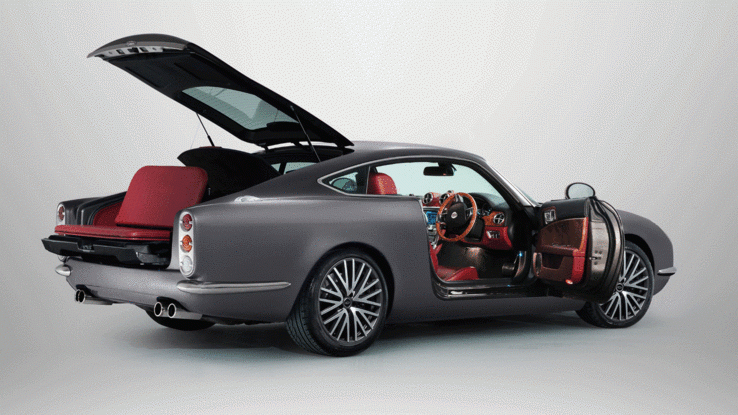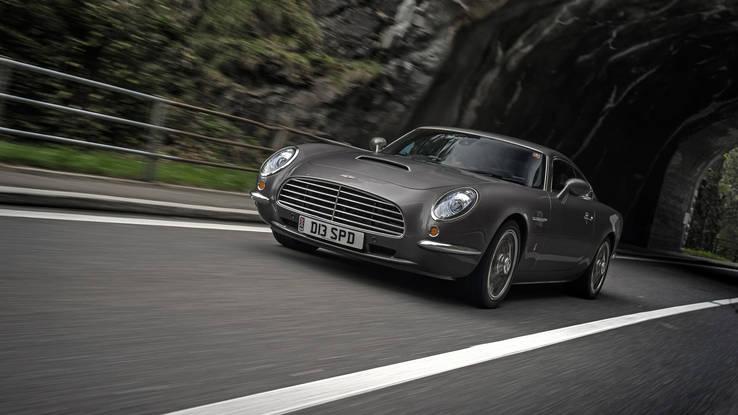Mr. Brown built this car for himself, but he’ll happily sell you one for $ 753,000
David Brown is riding shotgun in the plush leather seat of his creation — the David Brown Automotive Speedback GT — articulating his philosophy of luxury as we race up a mountain somewhere on the Monterey Peninsula. I’m sitting to his right in the driver’s seat, gripping a wood-rimmed steering wheel in a richly, yet tastefully, appointed cabin.
And from my extremely comfortable vantage point, his way of thinking is starting to make a lot of sense.
Imagine the perfect car for a transcontinental trip — a casual jaunt from, say, London to Monaco. A vintage Ferrari is the obvious choice: something fast, with dramatic proportions, a stylish interior and a heavenly engine note. But it also needs to be composed and coddling; nothing worse than showing up in Monte Carlo sweaty and stiff-necked.
What you need is a classic grand tourer, only with power-adjustable seats and a more or less bulletproof set of running gear. And functional air conditioning.
That’s what Brown wants, at least, and it’s what he was gunning for when he developed his Speedback GT. On the surface, the result is puzzling: Is there room in this world for a retouched Jaguar XKR convertible with a $ 753,000 starting price tag?
Actually, that’s not quite accurate — on the surface, there’s no trace remaining of the donor car. The exterior is a medley of 1960s styling cues; your first impulse is to call out the obvious Aston Martin elements, but Brown insists there’s some E-Type in there, as well. Here’s one case where photos can’t quite be trusted; the styling works surprisingly well when viewed in real life.
The liftback is a modern add-on, but it’s a practical one. “You can fit three sets of golf clubs in the back,” Brown says proudly. Plus, there’s room for a slick flip-down picnic seat.

Can’t get enough of that flip-down picnic seat.
Perhaps fittingly for a car built on the bones of a Jag, Brown took his “head full of ideas and images” of the ultimate GT to Alan Mobberley, formerly of Jaguar-Land Rover. “We put pictures of people like Sophia Loren and other famous models of the era up on the wall, played some rock music, stuck up some pictures of Riva speedboats and everything from that era that looked great … and that was it.”
A full-size clay model followed; digital scanning permitted aerodynamic refinements and also allowed the production of accurate forms. The body is hand-hammered, hand-shaped aluminum, but it’s free of the imperfections typical of period carrozzeria work thanks to digitally-rendered bucks.
The finished product, which seemed symmetrical so far as I could tell, rides on wire-spoke wheels wrapped in higher profile tires than you’ll see on a typical performance car these days. As with everything else on the car, that’s by design. “I hate low-profile tires, full stop,” Brown says, describing the Range Rover he recently bought as “a pimped-up thing for some drag strip. When I put the higher-profile tires on, the ride improved massively, as did the noise.” Alloy wheels, which look somewhat more comfortable on the car than the wires, are also available.
The old-school sensibility continues inside. “It’s a lot more vertical than what you find today,” Brown says of the dashboard. The windshield wraps around you a little bit; it’s the kind of thing you might not notice until someone mentions it. “The point about it is that it should be subtle,” he explains. “It should be there, but it should be something that is not immediately apparent.”
Compared the attention lavished on the interior and exterior, the Speedback’s mechanical bits have been more or less neglected. The rear suspension has been softened — something I’ve never heard a luxury/performance automaker brag about before — and there’s a new exhaust system, but the 5.0-liter supercharged heart is the same one you would have found on a stock XKR.

The basic parts of the donor Jag’s interior are visible inside the Speedback GT, but there are subtle — and not-so-subtle — differences spanning everything from seat construction to dash positioning.
Not that it really needed a boost: With 503 hp and, more importantly, 461 lb-ft of torque, there’s plenty of oomph to get the car going in a drama-free manner. Brown will build you a car with as much power as you want, provided that is what you want; the AJ133 V8 is certainly capable of higher output.
And, at first, a hotter engine would have been right up there on my Speedback GT order sheet. “You put it into sport mode,” Brown notices after a few minutes on the road. True enough; I tend to reflexively dial things up whenever I’m not facing gridlock traffic.
Brown does things differently. “I’ve never driven it like that,” he claims, after which I switch into regular drive mode. I can see why almost immediately: holding onto gears for longer than necessary, letting the supercharger whine and the engine drone — it all seems uncouth in this car, on these roads, while holding a conversation.
It’s a non-intuitive concept in this age of go-fast super-coupes, but the Speedback GT comes off as a car that’s meant to be driven fast, not quickly. “If you want the performance, it’s still there — but it’s less frantic, if you know what I mean,” Brown says of the relaxed, enjoy-the-journey feel of the car on the road. Soft and smooth but with a deep well of power from which you can draw at a moment’s notice, the whole effect is very much like that of an old car — and that’s meant in the most complimentary way possible.
In that sense, the Speedback GT is an unlikely counterpoint to, for the sake of example, a Singer 911. Both cars aggressively pursue their respective, if wildly divergent, goals; both flaunt their hand-crafted exclusivity (Brown says no more than 100 Speedback GTs will be built, if that); both are designed for clients who have no desire, or financial need, to compromise. Realistically, anyone who could afford one of those cars could afford both. So why muddle things up with a car that struggles to do it all?
Brown owns a rabid little Mercedes A45 AMG and rallies a Ford Puma. He’s a fan of the rowdy F-Type. He’s done endurance rallies in a range of classic cars, some less functional, durable and pleasant than others. All of which makes him the right man to credibly champion this old-fashioned take on luxury. “What we’re trying to do is all about style, all about a different look and feel to the car. We really are trying to go back to the great old days of GT motoring in terms of building something that you’ll want to spend all day in.”

The Speedback GT.
But will you actually want to spend all day in one — or buy one? Would-be American buyers will at least have the option. Since it’s based on a Jag, retains all of the emissions and safety gear of a Jag and will presumably be registered as a Jag, there’s reportedly no trouble getting one on the road here in the States.
Whether you like the Speedback GT is largely immaterial: By design, it is not a car for everyone. Even once you get past the sky-high price tag and the limited planned production run, Brown’s nostalgic sensibilities make the exterior a love-it-or-hate-it proposition. It attracted lots of smiles, thumbs-up and enthusiastic questions during my test drive, though, and given the caliber of what you’re likely to see stuck at a typical red light during Monterey car week that’s no mean feat. Beyond that, it has a well-defined purpose and it achieves it with no apparent compromise, which makes it a car worthy of respect.
Above all else, however, Brown stands by his creation, which I sense is ultimately all that really matters to him. “You could park it right next to that Bugatti, and I wouldn’t be ashamed of it,” Brown says, waving at a Veyron sitting in front of the Quail Lodge (and attracting absolutely zero attention from passers-by). “It’s not the poor relative. … It’s the different relative.”
Here’s to thinking different.




























